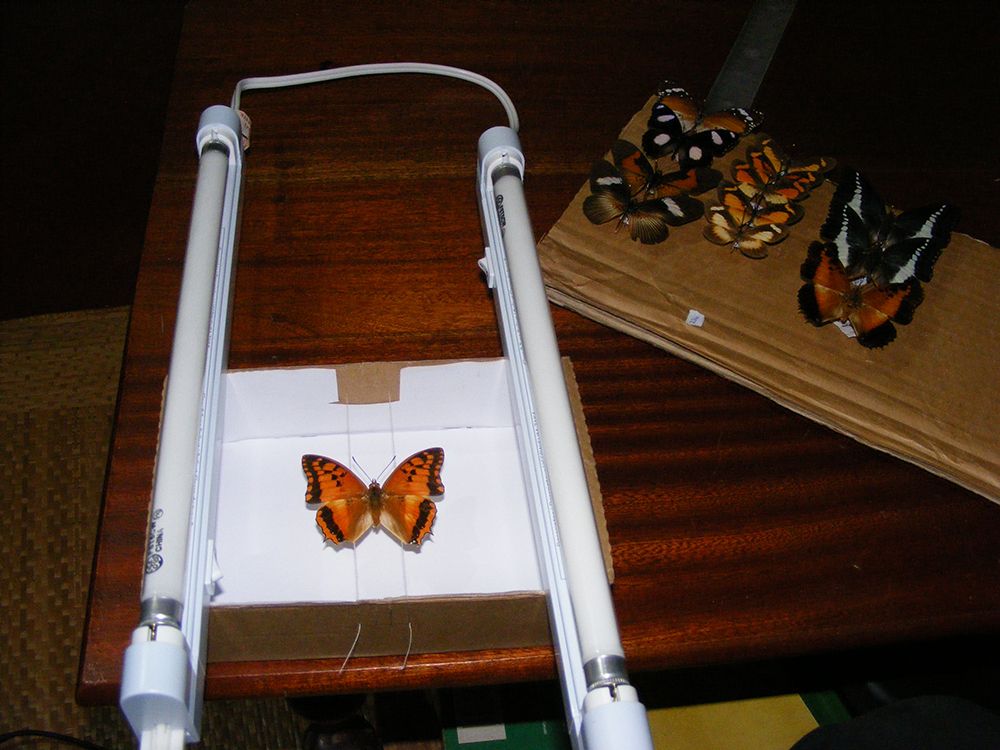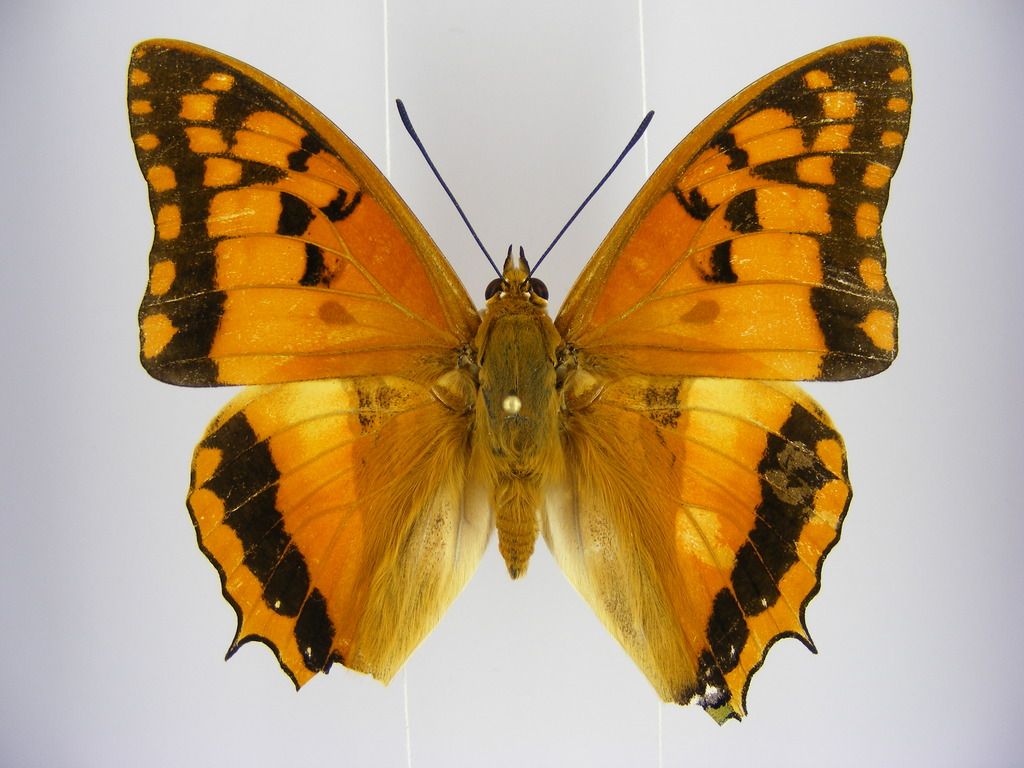|
|
Post by cabintom on Apr 16, 2016 8:20:09 GMT -8

FOR FULL RESOLUTION CLICK HEREThe grid is 1cm X 1cm and all specimens are to scale. Thanks for any help you might be able to provide. Tom *Also please ignore the typo.  |
|
|
|
|
|
Post by nomihoudai on Apr 16, 2016 11:48:54 GMT -8
Bottom right is a Lasiocampidae.
|
|
|
|
Post by nomihoudai on Apr 16, 2016 11:51:12 GMT -8
Now I read "1 other", well I am tired. I think it goes in the direction of Pachypasa.
|
|
|
|
Post by cabintom on Apr 16, 2016 20:51:21 GMT -8
I think it goes in the direction of Pachypasa. I worked my way through africanmoths.com to guess at these IDs and I didn't find any Pachypasa listed there. The closest I found was Gonometa (also Lasciompidae). |
|
|
|
Post by hewi on Apr 17, 2016 3:40:05 GMT -8
After Seitz "Afrikanische Spinner und Schwärmer", Pl. 33c it could be the female of Pachyna subfascia.  |
|
|
|
Post by africaone on Apr 17, 2016 3:47:52 GMT -8
1 Lobobunaea angasana femelle (a surprise for the locality)
2 Gonimbrasia anthinoides
3-4 Gonimbrasia dione
5-7 Gynanisa sp, probably hecqui
8 is no Gonometa, something like Pachypasa subfascia female
|
|
|
|
|
|
Post by cabintom on Apr 17, 2016 5:20:27 GMT -8
1 Lobobunaea angasana femelle (a surprise for the locality) 2 Gonimbrasia anthinoides 3-4 Gonimbrasia dione 5-7 Gynanisa sp, probably hecqui 8 is no Gonometa, something like Pachypasa subfascia female 5 is the same as 6 and 7? Interesting. I have 2 other specimens, that I have yet to set, that are of the same relative size and appearance as 6 & 7, so with 5 being noticeably smaller and the clear FW spot being on the outside of that thin dark band (unlike the other specimens) I figured it was something different. |
|
|
|
Post by africaone on Apr 17, 2016 6:39:23 GMT -8
Gynanisa is with a ? (they need to be verified. All the Gynanisa sp are extremely variable. I believe they are the same sp, but who knows ?
Can you photograph the underside and the discal part of all wings ?
|
|
|
|
Post by jonathan on Apr 17, 2016 9:58:45 GMT -8
I think it goes in the direction of Pachypasa. I worked my way through africanmoths.com to guess at these IDs and I didn't find any Pachypasa listed there. The closest I found was Gonometa (also Lasciompidae). How did you manage to take the photos without the shadows? Do you use a flash with the camera? Well done for the beautiful plate. |
|
|
|
Post by cabintom on Apr 17, 2016 10:09:19 GMT -8
Gynanisa is with a ? (they need to be verified. All the Gynanisa sp are extremely variable. I believe they are the same sp, but who knows ? Can you photograph the underside and the discal part of all wings ? I'll post undersides once I can (might be a few days from now). As for the discal part of the wings is the full resolution link I provided in the initial post not detailed enough? (Here's the link again: i.imgur.com/yTWoBGz.jpg ) |
|
|
|
Post by cabintom on Apr 17, 2016 10:43:05 GMT -8
I worked my way through africanmoths.com to guess at these IDs and I didn't find any Pachypasa listed there. The closest I found was Gonometa (also Lasciompidae). How did you manage to take the photos without the shadows? Do you use a flash with the camera? Well done for the beautiful plate. Thanks. The truth is I cheat a little.  This is my humble set-up:  The fluorescent tubes are 4100K, which is probably a bit low and effects the specimens' colours a bit (but it's not like I have much choice here in Congo), so I compensate by having the white balance adjusted on my camera and then doing further white balancing in photoshop afterwards. The specimens are suspended on those 2 white threads, which keeps all specimens at an equal distance from the light source. With the threads being spaced 2cm apart it also provides me with a convenient scale. Because I'm holding the camera in my hands, the distance from the lens to the specimen, and the angle, aren't always perfect or constant, so I take multiple photos and then select the best afterwards. Here's a typical result after white balancing in photoshop:  The last step, also involving photoshop, is cutting out the background. This step is probably not necessary, but it does allow me to nicely present specimens. Let me know if there are any questions. It's really not complicated. Tom |
|
|
|
Post by jonathan on Apr 17, 2016 11:31:53 GMT -8
Thanks a lot Tom for the detail and for the photos. I like your idea and the results are great. All photos need some retouching with photoshop. You can see my photos on my website: www.satyrinae.yolasite.com/ I do some retouching as well. Thanks once again. |
|
|
|
Post by cabintom on May 3, 2016 1:10:07 GMT -8
Gynanisa is with a ? (they need to be verified. All the Gynanisa sp are extremely variable. I believe they are the same sp, but who knows ? Can you photograph the underside and the discal part of all wings ? Here are the photos of the undersides (sorry, had to throw it together quickly). I also included an extra specimen that just came of the board.     |
|
|
|
Post by africaone on May 3, 2016 6:34:59 GMT -8
nice specimens
for me all are the same species, first slightly different, probably due to variation.
|
|